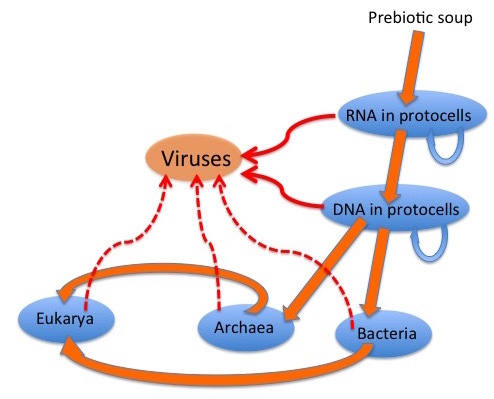Origins and evolution of viruses of eukaryotes: The ultimate modularity
Viruses and other selfish genetic elements are dominant entities in the biosphere, with respect to both physical abundance and genetic diversity. Various selfish elements parasitize on all cellular life forms. The relative abundances of different classes of viruses are dramatically different between prokaryotes and eukaryotes. In prokaryotes, the great majority of viruses possess double-stranded (ds) DNA genomes, with a substantial minority of single-stranded (ss) DNA viruses and only limited presence of RNA viruses. In contrast, in eukaryotes, RNA viruses account for the majority of the virome diversity although ssDNA and dsDNA viruses are common as well. Phylogenomic analysis yields tangible clues for the origins of major classes of eukaryotic viruses and in particular their likely roots in prokaryotes. Specifically, the ancestral genome of positive-strand RNA viruses of eukaryotes might have been assembled de novo from genes derived from prokaryotic retroelements and bacteria although a primordial origin of this class of viruses cannot be ruled out. Different groups of double-stranded RNA viruses derive either from dsRNA bacteriophages or from positive-strand RNA viruses. The eukaryotic ssDNA viruses apparently evolved via a fusion of genes from prokaryotic rolling circle-replicating plasmids and positive-strand RNA viruses. Different families of eukaryotic dsDNA viruses appear to have originated from specific groups of bacteriophages on at least two independent occasions. Polintons, the largest known eukaryotic transposons, predicted to also form virus particles, most likely, were the evolutionary intermediates between bacterial tectiviruses and several groups of eukaryotic dsDNA viruses including the proposed order “Megavirales” that unites diverse families of large and giant viruses. Strikingly, evolution of all classes of eukaryotic viruses appears to have involved fusion between structural and replicative gene modules derived from different sources along with additional acquisitions of diverse genes.
Graphic by Ed Rybicki
Source: www.sciencedirect.com
See on Scoop.it – Virology and Bioinformatics from Virology.ca
